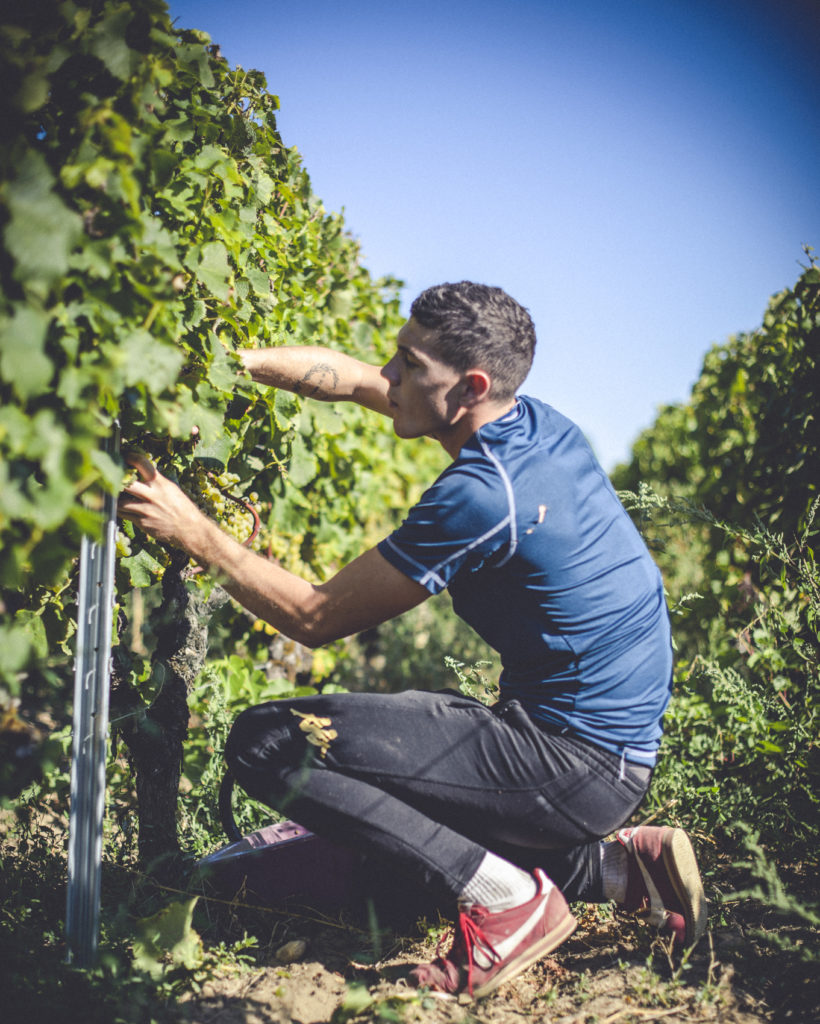ON THE VINEYARD
AND IN THE CELLARS
WORKING WITH RESPECT FOR THE LAND AND PEOPLE
Our health is a priority. Since the creation of a vineyard, sustainable agriculture has been in practice: no weed-killers or products classified as CMR (Carcinogen – Mutagen – Reprotoxic) are used. This is reinforced by a programme of bio-controlled products that uses natural mechanisms and interactions integrated into an overall plant protection strategy aimed at keeping bio-aggressors below their threshold of harmfulness. Another goal is to strengthen our vines against diseases and, over time, to reduce the need for our intervention. This bio-controlled programme may be pioneering in presenting alternatives to the usual bio-treatments such as the use of copper. Instead, we use orange peel whenever the threat of disease is not too great. Lastly, since the 2019 vintages, the estate has been certified as having High Environmental Value – Level 3 (HEV 3), validating Château Jouvente’s environmental performance in terms of biodiversity, the use of plant-protection products as well as fertiliser and water resource management.

ON THE VINEYARD
Being a winemaker means working long hours in the vineyard. As soon as the dormancy of winter is over, we go through the rows of vines several times during the year to aerate the soil, prune, destalk, remove the suckers and pick off leaves. This pre-harvest work carried out by our staff and machines is a necessary step in obtaining well-ripened and balanced grape bunches.


© thibaut Plaire
Maintaining our vines involves work on the soil with labour carried out all year long. Given that our soil is low-nutrient and cool, it is important to aerate it and to encourage deep rooting of the vine. We do not use any chemical weed killers.
Manual work is essential right up to the harvest. As soon as the first leaves appear, we work on limiting the non-fruit-bearing branches by removing them.
AGRICULTURE WITH HEV 3 CERTIFICATION
We practice responsible agriculture and our work on the land is respectful of the environment and people. Since the 2019 vintages, the estate has been certified as having High Environmental Value – Level 3 (HEV 3), validating Château Jouvente’s environmental performance in terms of biodiversity, the use of plant-protection products as well as fertiliser and water resource management.
This is reinforced by a programme of bio-controlled products that use natural mechanisms and interactions to better protect the vines against bio-aggressors and reduce the need for our intervention. This bio-controlled programme may be pioneering in presenting alternatives treatments, whether conventional or organic.

©Thibaut Plaire

© thibaut Plaire
OUR LANDS
The land at Château Jouvente is typical of our appellation. Our soil consists of stones and pebbles that were scoured by the Garonne river hundreds of thousands of years ago.
Our soil is made up, for our grape varieties, of sand and gravel, and for our red grape varieties, of clay and gravel. It is low-nutrient and cool, which enables us to build on a lengthy vegetative cycle and create high aromatic potential.
OUR MANUAL HARVESTS
At Château Jouvente, our entire harvest is done by hand. This is firstly because wine is a human adventure. Throughout the year, we deploy our efforts along with our workers, to plant, remove leaves, destalk, etc. and lastly, to harvest the grapes.
We also believe that the human eye is sufficiently equipped to choose healthy grape bunches and cut away damaged fruit.
In addition, manual harvests at Château Jouvente last over a month. Depending on the climatic pressure, which along with the grape maturity is the triggering factor for harvests, we can choose the exact moment for harvesting each plot. As such, we are able to achieve greater precision by “customising” the harvest as best as possible.
Photo © thibaut Plaire
WORK IN THE WINE CELLAR
Red Graves Wines
Our red wine grapes macerate for 4 to 6 weeks. This period enables the extraction of noble material from the skin of the grapes: tannins, aromas and colour. A “cap” forms at the top of the vat. As such, regular stirring is required. This involves taking the juice from the base to the top of the vat on the pomace cap. By crossing the cap several time, the must becomes enriched with the selected material. After assembling various grape varieties, our red Graves wine is aged for 12 months in oak barrels that are 25% new. This makes a more mellow wine and increases its structure and aromas.


White Graves Wines
The white grapes of our four grape varieties (Semillon, Sauvignon Blanc, Sauvignon Gris and Muscadelle) are harvested by hand, then gently pressed. The extracted grape must is allowed to settle, which eliminates the largest sediments. It then ferments in oak barrels that are 40% new in our underground cellar. Once the fermentation ends, the ageing on lees with stirring begins and lasts 9 to 10 months. The fine lees at the base of the barrels are suspended by regular stirring with a special cane. This gives more body and complexity to the wine both in terms of aroma and taste. In addition, the antioxidant properties of the lees help to increase the wine’s storage potential.





